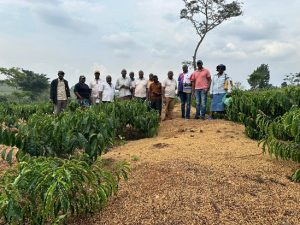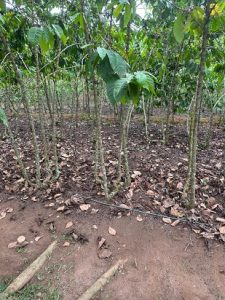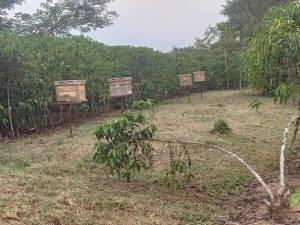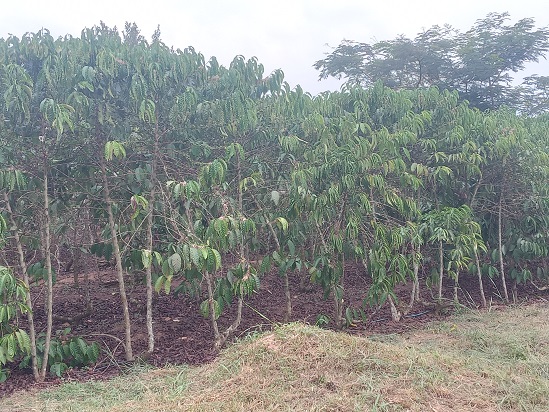Coffee under 3mX1m at Deus Nuwagaba’s farm in Namayumba/Business Focus photo
Plant density in Robusta coffee is an unresolved issue in low volume producing countries especially when compared with leading producers. This explains why there’s an ongoing debate about the implementation of the 3m by 1m (10ft by 3ft) Robusta coffee spacing method commonly known as Brazilian method in Uganda among coffee stakeholders.
Uganda Coffee Development Authority (UCDA) recommends 3m by 3m (10ft by 10ft) spacing for Robusta, but some farmers are opting for closer/reduced spacing regimes in order to maximize productivity.
In a move to learn more about the 3mX1m spacing regime, a group of farmers on July 19, 2024, visited Alba Farm that has successfully implemented the 3mx1m spacing regime over seven years.
The nine-acre farm sits mainly on rocky soils with a gently slopping topography and is located in Luguzi LC1, Namayumba Sub-County in Wakiso district.
The farm is owned by Deus Nuwagaba, the Deputy Managing Director at the National Union of Coffee Agribusiness and Farm Enterprises (NUCAFE).
The training and the guided farm tour were led by Deus Taremwa, the Manager of the farm and James Musule, one of the promoters of Good Agronomic Practices (GAPs) in Namayumba.
Unlike the 3mx3m spacing where an acre accommodates about 450 coffee trees, under the 3mx1m spacing method, an acre will have 1,333 coffee trees.

From observation, most of the coffee trees at Alba Farm have three to four stems. However, the stems are a bit smaller compared to those under wider spacing.
The 3mx1m spacing regime can succeed in Uganda only if a farmer carries out irrigation, soil testing and right application of fertilizers, training/bending of all stems and other Good Agronomic Practices.
The farm is weed free and the devastating Black Coffee Twig Borer isn’t a big challenge despite the closer spacing method used. What’s their secret?
Musule says that at around knee height, all the stems at Alba farm are trained/bent to form an L-like shape. This allows the coffee trees to receive sunlight equally as there is a gap left in between the stems.

“We maintain three to four stems per tree. However, we advise that you keep only stems that you’re able to feed and care for. If you can’t sustain four stems, you can maintain two stems that you’ll properly take care of. This kind of training stems is good regardless of the spacing method one chooses to use,” Musule says, adding that one must also have capacity to remove all the suckers from the trees. Indeed, coffee trees at Alba farm are free from suckers.
Weed management
Given the fact that the coffee spacing is reduced, the canopy subdues the weeds. However, the weeds that emerge are well managed.
“We don’t use herbicides. We balance between weeding and slashing,” he says.
Additionally, the farm uses coffee husks got from their wet milling machine for mulching. Outside coffee husks aren’t entertained at the farm to prevent the spread of diseases.
Controlling Twig Borer
Deus Taremwa, the Manager of the farm, says they control the devastating Black Coffee Twig Borer by removing the affected twigs early in the morning and burning them.
“We remove the affected twigs before 10am when the Coffee Twig Borer is still inside. When it becomes hot, they run away so we remove them very early in the morning. As we cut them, we ensure we put them in a bag so that the eggs and the pests don’t fall off to the ground,” he says, adding that they also occasionally apply recommended pesticides.
Irrigation, fertilizers key
Musule adds that without irrigation and the use of fertilizers, the 3mx1m spacing regime can’t be implemented successfully.
Alba farm uses drip irrigation. The farm has a dam where water is pumped using a solar powered system to raised tanks and water is released through the drip lines by gravitational force.

According to Musule, the farm has a proper fertilizer programme that is followed routinely. He says the the type of fertilizers they use is determined by the periodical soil tests and analysis they carryout.
“When soil analysis is done, you avoid wasting money on unwanted fertilizers. When you apply the right fertilizers, they are released to the plant,” he says, adding that diseases like Red Blister can be avoided if the right fertilizers are used.
Bees
To increase on yields and productivity, the farm has about five beehives.
Taremwa says the bees help in pollination and ensure that the flowers are well fertilized. He recommends every farm to have some beehives, noting that proper fertilization results into good cup quality.

Yields
At Alba Farm, they harvest an average of 2.5kgs of Fair Average Quality (FAQ) aka Kase per coffee bush per year. This means they are able to harvest about 3,332.5kgs of FAQ from the 1,333 coffee trees planted in an acre under the 3mx1m spacing. According to the farm owners, they are able to make a profit after deducting the farm expenses. In comparison, if a farmer can get 5kgs of FAQ from 450 coffee trees under 3m by 3m spacing method, they’ll only be able to get 2,250kgs of FAQ per year. This means a farmer using 3m by 1m will still be ahead in terms of yields per acre by 1,082.5kgs of FAQ.
What research says
An on-farm study by Ugandan scientists at National Coffee Research Institute (NaCORI) and National Agricultural Research Organization (NARO) revealed that while the 3mx1m spacing method gives higher yields, close spacing creates a lot of competition among Robusta coffee trees which compromises on their robustness attributes.
The study shows that while coffee farmers are likely to realize higher yields using a spacing method of 3mx1m compared to the traditional 3mx3m, farmers who opt for the 3mx1m spacing method must invest more to reap the benefits.
The results also show that there was high incidences of pests and diseases under closely spaced fields compared to widely spaced fields. The researchers say more studies need to be conducted before the 3mx1m spacing regime is recommended to farmers.
According to the findings of the study published in the Australian Journal of Crop Science and obtained by Business Focus, the study aimed to compare on-farm performance of Robusta coffee under two contrasting spacing regimes of Uganda’s 3mx3m and Brazil’s 3mx1m. The study compared the pest incidence and damage, disease incidence and severity, growth response and yield potential under the two contrasting spacing regimes.
The research was led by Godfrey Sseremba and assisted by Godfrey Hubby Kagezi, Judith Kobusinge, Pascal Musoli, David Akodi, Nicholas Olango, Patrick Kucel, Job Chemutai, Joseph Mulindwa and Geofrey Arinaitwe.
The study was imposed in July 2017 on already established farmer’s Robusta coffee fields at Bunjako Island, Buwama sub-county in Mpigi district.
The study reveals that there was a significant difference in growth response between spacing regimes for canopy height (dCAH), number of primaries (dNOP), number of stems (aNOS), leaf blade length (aLBL) and leaf blade width (aLBW).
“The dCAH was higher under 3mx1m spacing than for 3mx3m spacing. Specifically, dCAH for closely coffee fields was higher by 7.91 cm and 11.84 cm when compared to widely spaced fields 2 and 3, respectively. The dNOP for 3mx1m and 3mx3m spacing was 0 and 5, respectively. The aNOS was lower for close spacing at 2 stems/tree than wide spacing at 3 stems/tree,” the study results indicate.
Further, the study reveals, longer leaves (24.4 cm) were obtained under wide spacing as compared to close spacing (23.6 cm). Conversely, wider leaves were obtained under close spacing (10.4 cm) compared to wide spacing (9.9 cm).
According to the study, “It is suggested that close spacing creates a lot of competition among Robusta coffee trees which compromises on their robustness attributes (Sakai et al., 2013; Salamanca-Jimenez). However, a follow-up detailed study under complete control of planting dates and blocking for variation management is necessary for solid recommendations.”
Green bean yield potential
The study also shows that there was a significant difference in yield potential between spacing regimes for average yield per tree (aYT) and average yield per hectare (aYH).
“Specifically, aYH was higher under close spacing (3mx1m) at 5.82 t cc/ha than wide spacing at 4.80 t cc/ha (3mx3m). The aYT was however, higher under wide spacing at 2.31 kg cc/tree than close spacing which generated 1.75 kg cc/tree. Similarly, higher number of berries per tree was observed under wide spacing at 6,934 berries per tree than close spacing which produced 5,241 berries per tree,” the study says.
The observation by researchers suggests that as plant density increases, yield increases as earlier suggested by AnimKwapong et al. (2010) and Paulo et al. (2010).
“It is imperative that in-depth analysis of relationships among pest incidence, disease incidence and severity, growth response and yield in coffee is conducted. So far, BCTB incidence is shown to be higher under close spacing than wide spacing yet this study also suggests that better yield is achievable as plant density is increased. Unless the pests and diseases whose incidence and severity increases with plant density are sustainably managed (Bell et al., 1995; Canell, 1985; DaMatta et al., 2007; Paulo et al., 2010), the apparent yield increase under high plant densities may not be realized by farmers,” the study says.
“It is our view that whereas yield potential is high at high tree densities, a detailed longitudinal analysis on the achievability of this apparent yield potential amidst pest, disease and abiotic constraints is conducted as basis for solid recommendation to farmers,” researchers say in the study.
For tips or get featured, opinions and advertising, Tel: 0775170346/0703828741/staddewo@gmail.com. Follow us on Twitter: @TaddewoS @BusinessFocusug. For quality Clonal Coffee Planting materials and consultancy, call the same telphone numbers (0775170346/0703828741)







We request the government to support farmers with irrigation. This can be achieved by giving a tax holiday on the equipment.
The method of specing 3m×1m,is very good, give high economy, wealth creation for quick development and easy management for weeding etc.
I have learned more on how to control twing bore
Very educative information access fora
Very educative continue with this program